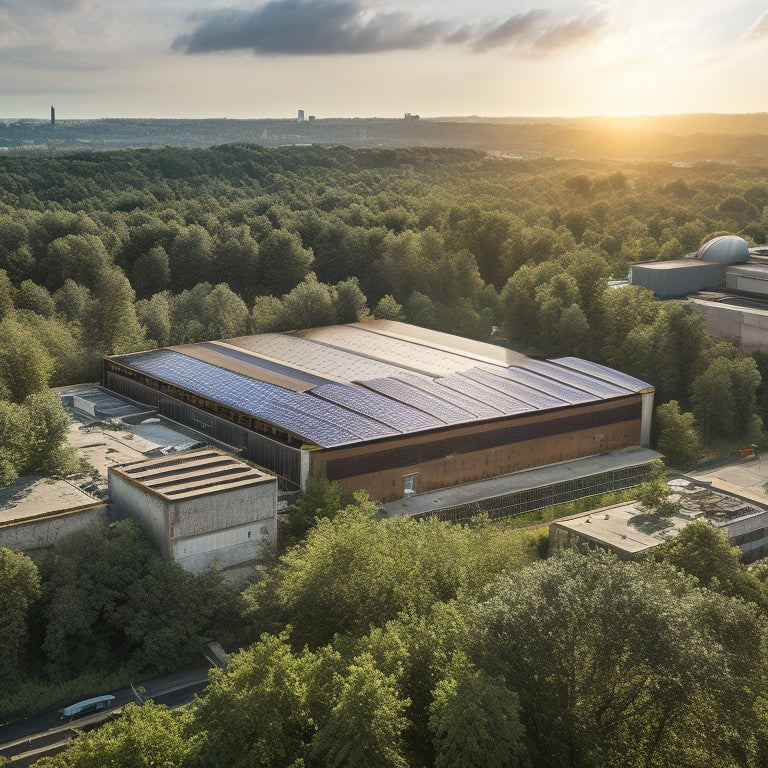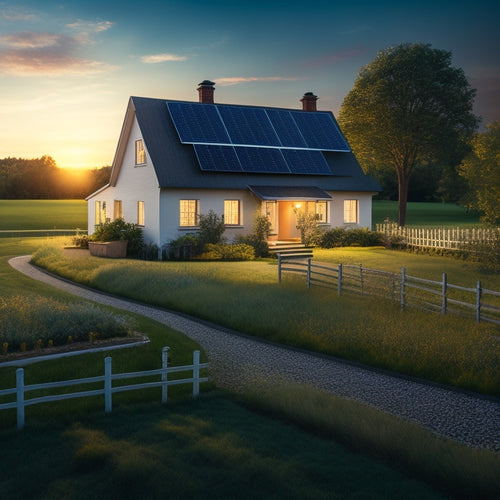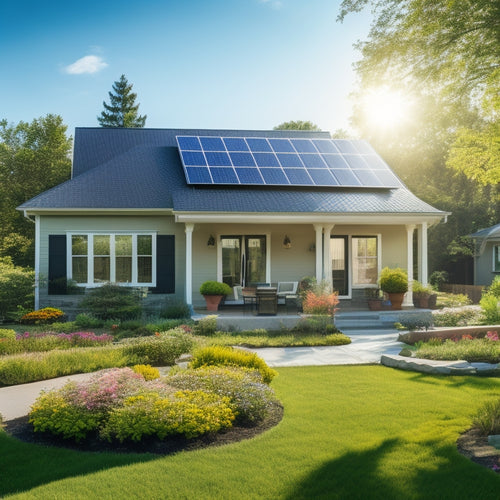
Transforming Industrial Buildings With Solar Power
Share
You're altering your industrial building into a sustainable powerhouse by utilizing the energy of the sun, revealing a future of reduced operating costs, increased energy independence, and a considerably lower carbon footprint. Industrial solar power offers numerous benefits, including environmental sustainability, economic opportunities, and energy independence. To get started, you'll need to assess your building's potential by evaluating its roof condition, orientation, and energy usage patterns. By understanding the design and installation process, financial incentives, and common challenges, you'll be well on your way to creating a more efficient and sustainable industrial space – and that's just the beginning of your solar-powered expedition.
Key Takeaways
- Industrial solar power reduces reliance on fossil fuels, lowering carbon footprint and enhancing sustainability for a cleaner environment.
- Assessing a building's potential involves evaluating roof condition, building orientation, energy usage patterns, and compliance with regulations.
- A well-designed solar energy system can achieve a 10-20% reduction in energy costs, increasing production capacity and extending equipment lifespan.
- Financial incentives, such as tax credits and rebates, can offset installation costs, while depreciation benefits provide additional tax savings.
- Overcoming common challenges, including financing and regulatory barriers, is crucial to successfully transforming industrial buildings with solar power.
Benefits of Industrial Solar Power
By utilizing the power of the sun, industrial facilities can greatly reduce their reliance on fossil fuels and lower their carbon footprint.
You'll achieve increased sustainability and contribute to a cleaner environment. Industrial solar power also creates job opportunities in manufacturing, installation, and maintenance, enhancing local economies.
Your facility will become more resilient to power outages and price fluctuations, ensuring business continuity and reduced operational risks.
With energy independence, you'll have more control over your energy costs and reduce your reliance on the grid. Furthermore, you'll experience reduced emissions, aligning with government regulations and enhancing your brand reputation.
Industrial solar power is a long-term investment, offering predictable energy costs and significant savings over time.
You'll also benefit from technological advancements, as the industry continues to evolve and improve.
Assessing Your Building's Potential
When evaluating your building's potential for solar power, you'll need to take into account several key factors.
You'll want to assess the condition of your roof, as a sound roof is essential for supporting solar panels.
Additionally, you'll need to examine your building's orientation and energy usage patterns to determine the ideal placement and size of your solar array.
Roof Condition Matters
Your industrial building's roof is more than just a physical barrier; it's a critical factor in determining the feasibility of a solar power installation.
Before you can utilize the power of the sun, you need to assess the condition of your roof to verify it can support a solar panel system.
To evaluate your roof's potential, you'll need to conduct a thorough roof inspection. This involves examining the roof's structure, material, and overall condition.
Here are some key factors to take into account:
-
Age and condition of the roof: Is your roof nearing the end of its lifespan, or is it still in good condition?
-
Structural integrity: Can your roof support the weight of solar panels and withstand environmental stresses like wind and snow?
-
Weatherproofing: Are there any gaps or cracks that need to be sealed to prevent water damage and guarantee a watertight seal for your solar panels?
- Obstacles and shading: Are there any obstacles, such as skylights or vents, that could interfere with the installation or performance of your solar panels?
Building Orientation Impacts
After evaluating your roof's condition, it's time to assess another essential factor in determining the feasibility of a solar power installation: your building's orientation.
The direction your building faces, along with its surroundings, affects the amount of solar access it receives. A shading analysis will help identify any obstacles, such as trees or neighboring buildings, that could impact energy production. Ideal tilt and orientation of your solar panels will also be significant in maximizing energy output.
Weather considerations, like the local climate and seasonal changes, must also be taken into account. The site layout and environmental impact of your installation should be assessed to guarantee compliance with zoning regulations.
By considering these factors, you can achieve energy independence and potentially feed excess energy back into the grid. A well-planned installation will also require minimal maintenance strategies, guaranteeing ideal performance over time.
Energy Usage Patterns
Beyond the building's orientation, understanding your energy usage patterns is vital in determining the potential of your industrial building to harness solar power.
Analyzing your energy consumption helps identify opportunities to optimize energy efficiency and maximize the benefits of solar power integration.
To assess your building's potential, consider the following key aspects of energy usage patterns:
-
Peak energy usage hours: Identify the times of day when your energy consumption is highest, as this will impact the size and type of solar power system you need.
-
Energy consumption by department: Break down energy usage by department or area to pinpoint opportunities for energy efficiency improvements.
-
Seasonal energy fluctuations: Understand how energy consumption varies by season to guarantee your solar power system is designed to meet your building's needs year-round.
- Usage analytics: Analyze historical energy usage data to identify trends and patterns, enabling you to make informed decisions about solar power integration.
Designing a Solar Energy System
Designing a Solar Energy System
When designing a solar energy system for your industrial building, you'll need to evaluate several factors to guarantee maximum energy output.
First, you'll need to determine the best solar panel types for your building's specific energy needs. Monocrystalline, polycrystalline, and thin-film solar panels are popular options, each with their own benefits and drawbacks. Monocrystalline panels are highly efficient but expensive, while thin-film panels are cheaper but less efficient.
Next, you'll need to determine the system sizing required to meet your energy demands. This involves calculating your building's energy usage patterns, factoring in elements like roof size, shading, and local building codes.
A properly sized system will assure that you're generating enough power to meet your energy needs while avoiding overspending on unnecessary equipment.
Installation and Maintenance Costs
You've carefully sized your solar energy system to meet your industrial building's energy demands.
Now, it's time to evaluate the installation and maintenance costs associated with your new system.
When it comes to installation, the cost will depend on various factors, including the size of your system, the complexity of the installation, and the installation techniques used.
Here are some key factors to take into account:
- Labor costs: The cost of hiring a qualified installation team, including electricians and roofers.
- Equipment costs: The cost of the solar panels, inverters, and other necessary equipment.
- Permitting and inspection fees: The cost of obtaining necessary permits and undergoing inspections.
- Mounting and tracking system costs: The cost of the racking and tracking system that holds the solar panels in place.
To guarantee your system operates at peak performance, it's vital to establish a regular maintenance schedule.
This may include tasks such as cleaning the solar panels, inspecting the system for damage, and performing routine repairs.
Incentives for Industrial Solar
You'll find that investing in industrial solar power comes with significant financial benefits.
Federal tax credits are available to help offset the upfront costs, and you can also expect lower operating costs thanks to reduced energy expenses.
Additionally, many states offer rebate programs to further incentivize the adoption of solar power in industrial settings.
Tax Credits Available
Several federal and state governments offer lucrative tax credits to encourage industrial building owners to adopt solar power.
As you consider altering your industrial building with solar power, you'll want to take advantage of these incentives to maximize your investment benefits.
Here are some key tax credits available to you:
-
Federal Investment Tax Credit (ITC): You can claim a credit of up to 30% of the total project cost, which can greatly reduce your tax liability.
-
State Tax Credits: Many states offer additional tax credits, often with varying rates and eligibility requirements.
-
Depreciation Benefits: You can depreciate your solar equipment over a five-year period, providing additional tax savings through accelerated depreciation schedules.
- Environmental Credits: You may be eligible for credits or grants for reducing your carbon footprint and meeting environmental sustainability goals.
Lower Operating Costs
As your industrial building hums with renewed energy, the meter starts ticking in your favor - literally. With solar power, you're no longer beholden to fluctuating energy costs. You're in control, utilizing the sun's energy to power your operations.
Here's how you'll benefit:
| Energy Savings | Operational Efficiency | Cost Reduction |
|---|---|---|
| 10-20% reduction in energy costs | Increased production capacity | Lower overhead expenses |
| Extended equipment lifespan | Optimized energy usage | Improved bottom line |
| Reduced carbon footprint | Enhanced brand reputation | Increased competitiveness |
State Rebate Programs
Taking advantage of state rebate programs can greatly offset the upfront costs of industrial solar installations, making the shift to renewable energy even more attractive.
By leveraging these incentives, you can considerably reduce the financial burden of converting to solar power and accelerate your return on investment.
To tap into these programs, you'll need to traverse the state eligibility criteria and application process. Here's what you need to know:
-
Check your state's eligibility criteria: Each state has its own set of requirements for industrial solar projects, including system size, location, and installation timelines.
-
Review the application process: Understand the documentation and paperwork required to apply for the rebate program, including system design and installation plans, energy usage data, and proof of payment.
-
Determine the rebate amount: Calculate the amount of rebates you're eligible for based on your system size, installation costs, and state-specific incentives.
- Plan for ongoing compliance: Verify you understand the ongoing reporting and maintenance requirements to maintain rebate eligibility and avoid potential penalties.
Overcoming Common Challenges
Frequently, industrial building owners and facility managers encounter obstacles when integrating solar power into their existing infrastructure. You may face challenges in securing financing options, maneuvering regulatory barriers, and guaranteeing system scalability.
Staying up-to-date with technology advancements is vital to maximize energy output and minimize costs. Additionally, workforce training and integration strategies are important to guarantee a smooth shift to solar power.
Public perception and environmental impact are also key considerations. You'll need to address concerns about aesthetics, noise levels, and potential disruptions to operations.
Furthermore, you must assess the environmental impact of your solar installation, including land use, water consumption, and waste management.
To overcome these challenges, it's important to develop a thorough plan that addresses each of these factors. By doing so, you can guarantee a successful solar power integration that meets your energy needs while minimizing risks and costs.
Case Studies and Success Stories
The successful integration of solar power into industrial buildings is exemplified by numerous case studies and success stories. These real-world examples demonstrate the scalability potential of solar power and its ability to provide long-term sustainability.
-
Renewable Energy Hub: A former manufacturing facility in California was converted into a renewable energy hub, featuring a 2.5-megawatt solar array. This project showcases innovative technologies and successful implementations, yielding significant financial returns and environmental benefits.
-
Industrial Park Revitalization: A solar-powered industrial park in New Jersey was developed on a 150-acre brownfield site. This project highlights the community impact of solar power, creating jobs and stimulating local economic growth.
-
Distribution Center Upgrade: A major retailer upgraded its distribution center in Texas with a 1.2-megawatt solar rooftop system. This project demonstrates the potential for solar power to reduce energy costs and increase stakeholder engagement.
- Historic Building Restoration: A 100-year-old industrial building in Massachusetts was restored and equipped with a 500-kilowatt solar array. This project showcases the feasibility of integrating solar power into historic buildings, preserving their character while achieving long-term sustainability.
These case studies and success stories illustrate the potential of solar power to convert industrial buildings, providing a roadmap for future projects and stakeholder engagement.
Energy Efficiency and Savings
How can industrial buildings maximize their energy efficiency and savings with solar power? By conducting energy audits, you can identify areas of inefficiency and opportunities for improvement.
Renewable integration with solar power can greatly reduce your energy consumption from the grid. Implementing consumption tracking systems allows you to monitor your energy usage in real-time, making it easier to optimize your energy management strategy.
To achieve your sustainability goals, consider partnering with utilities to develop customized energy plans that meet your needs. By investing in solar power, you can reduce your reliance on the grid and move towards grid independence.
This not only saves you money but also increases your operational efficiency. With energy management systems, you can optimize your energy usage and reduce waste.
Future of Industrial Solar Power
Embracing innovative technologies and policies, you're ready to revolutionize the industrial solar power environment.
As you look to the future, emerging technologies and sustainability trends will play an important role in shaping the industry.
Here are four key areas to watch:
-
Bifacial Solar Panels: These advanced panels can increase energy output by up to 25%, making them an attractive option for industrial buildings.
-
Energy Storage Systems: Advancements in battery technology will enable more efficient and cost-effective energy storage, allowing industrial buildings to optimize their solar power usage.
-
Smart Grids and Microgrids: These advanced systems will enable industrial buildings to manage their energy distribution more efficiently, reducing waste and increasing reliability.
- Building-Integrated Photovoltaics (BIPV): BIPV systems will allow buildings to generate electricity while also serving as a structural component, further blurring the line between design and energy production.
As the industry continues to evolve, it's vital to stay informed about these emerging trends and technologies to remain competitive and at the forefront of industrial solar power innovation.
Frequently Asked Questions
Can Industrial Solar Panels Be Installed on Rooftops With Skylights?
You can install industrial solar panels on rooftops with skylights, but you'll need to assess the skylight considerations, ensuring proper sealing and waterproofing to maintain the rooftop's integrity and avoid potential leaks during rooftop installations.
How Do Solar Panels Affect Building Insurance Premiums?
You'll likely see a minimal impact on your building's insurance cost after a solar installation, as most policies cover the system as part of the overall property value, with some insurers even offering discounts for sustainable features.
Are Solar Energy Systems Compatible With Existing HVAC Systems?
As you weigh the benefits of solar energy, you're wondering if it'll play nice with your existing HVAC system. Fear not, the answer is yes! With proper system integration, solar energy systems can seamlessly complement your current setup, enhancing energy efficiency and your bottom line.
Can Industrial Solar Power Be Used for Electric Vehicle Charging?
You can utilize industrial solar power for electric vehicle charging, enabling you to fuel your industrial fleet through solar charging, reducing emissions and operating costs while increasing energy independence and sustainability.
Do Solar Panels Increase the Risk of Roof Leaks or Damage?
You're right to wonder if solar panels increase the risk of roof leaks or damage; however, a properly installed system won't compromise roof integrity, despite installation challenges, as long as you guarantee a watertight seal and regular maintenance checks.
Conclusion
You've made it to the end of this expedition, and what a bright future you're facing - quite literally! Who would have thought that those old, rundown industrial buildings could be changed into lighthouses of sustainability? It's almost ironic that the very structures that once guzzled energy are now capable of generating it. As you utilize the power of the sun, remember that you're not only saving the planet, but also saving your bottom line. The future of industrial solar power is looking brighter than ever - and so is your wallet!
Related Posts
-

Solar Power Advantages for Rural Communities
Solar power presents numerous advantages for rural communities. You can greatly reduce energy costs, potentially by u...
-

Cost-Effective Solar Solutions for Rural Homes
Cost-effective solar solutions can alter your rural home by enhancing energy independence and slashing utility bills....
-

Affordable Solar Panels for Home Use
Affordable solar panels offer you a smart way to cut down on energy costs while promoting sustainability. With govern...


